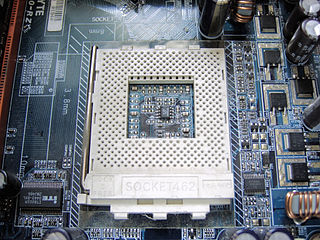
Athlon is the brand name applied to a series of x86-compatible microprocessors designed and manufactured by Advanced Micro Devices (AMD). The original Athlon was the first seventh-generation x86 processor and was the first desktop processor to reach speeds of one gigahertz (GHz). It made its debut on June 23, 1999.
Celeron is a brand name given by Intel to a number of different low-end IA-32 and x86-64 computer microprocessor models targeted at low-cost personal computers.
Pentium 4 is a brand by Intel for an entire series of single-core CPUs for desktops, laptops and entry-level servers. The processors were shipped from November 20, 2000, until August 8, 2008.

A pin grid array, often abbreviated PGA, is a type of integrated circuit packaging. In a PGA, the package is square or rectangular, and the pins are arranged in a regular array on the underside of the package. The pins are commonly spaced 2.54 mm (0.1") apart, and may or may not cover the entire underside of the package.

Socket 370 is a CPU socket first used by Intel for Pentium III and Celeron processors to first complement and later replace the older Slot 1 CPU interface on personal computers. The "370" refers to the number of pin holes in the socket for CPU pins.

In computer hardware, a CPU socket or CPU slot comprises one or more mechanical components providing mechanical and electrical connections between a microprocessor and a printed circuit board (PCB). This allows for placing and replacing the central processing unit (CPU) without soldering.

The land grid array (LGA) is a type of surface-mount packaging for integrated circuits (ICs) that is notable for having the pins on the socket rather than the integrated circuit. An LGA can be electrically connected to a printed circuit board (PCB) either by the use of a socket or by soldering directly to the board.

LGA 775, also known as Socket T, is an Intel desktop CPU socket. LGA stands for land grid array. Unlike earlier common CPU sockets, such as its predecessor Socket 478, the LGA 775 has no socket holes; instead, it has 775 protruding pins which touch contact points on the underside of the processor (CPU).

Socket F is a CPU socket designed by AMD for its Opteron line of CPUs released on August 15, 2006. In 2010 Socket F was replaced by Socket C32 for entry-level servers and Socket G34 for high-end servers.

LGA 771, also known as Socket J, is a CPU interface introduced by Intel in 2006. It is used in Intel Core microarchitecture based DP-capable server processors, the Dual-Core Xeon is codenamed Dempsey, Woodcrest, and Wolfdale and the Quad-Core processors Clovertown, Harpertown, and Yorkfield-CL. It is also used for the Core 2 Extreme QX9775.

Socket PAC611 is a 611 pin microprocessor socket designed to interface an Intel Itanium 2 processor to the rest of the computer. It provides both an electrical interface as well as physical support. This socket is designed to support a microprocessor module.
Gulftown or Westmere-EP is the codename of an up to six-core hyperthreaded Intel processor able to run up to 12 threads in parallel. It is based on Westmere microarchitecture, the 32 nm shrink of Nehalem. Originally rumored to be called the Intel Core i9, it is sold as an Intel Core i7. The first release was the Core i7 980X in the first quarter of 2010, along with its server counterpart, the Xeon 3600 and the dual-socket Xeon 5600 (Westmere-EP) series using identical chips.

Bloomfield is the code name for Intel high-end desktop processors sold as Core i7-9xx and single-processor servers sold as Xeon 35xx., in almost identical configurations, replacing the earlier Yorkfield processors. The Bloomfield core is closely related to the dual-processor Gainestown, which has the same CPUID value of 0106Ax and which uses the same socket. Bloomfield uses a different socket than the later Lynnfield and Clarksfield processors based on the same 45 nm Nehalem microarchitecture, even though some of these share the same Intel Core i7 brand.

LGA 1155, also called Socket H2, is a socket used for Intel microprocessors based on Sandy Bridge and Ivy Bridge microarchitectures.

Skylake is the codename used by Intel for a processor microarchitecture that was launched in August 2015 succeeding the Broadwell microarchitecture. Skylake is a microarchitecture redesign using the same 14 nm manufacturing process technology as its predecessor, serving as a "tock" in Intel's "tick–tock" manufacturing and design model. According to Intel, the redesign brings greater CPU and GPU performance and reduced power consumption. Skylake CPUs share its microarchitecture with Kaby Lake, Coffee Lake and Cannon Lake CPUs.

Socket G2, also known as rPGA 988B is Intel's CPU socket used with their line of mobile Core i7, the successor to the Core 2 line, and also with several mobile Core i5 and Core i3 processors. It is based on Intel's Sandy Bridge architecture. Like its predecessor, socket G1 systems, it can only run in dual-channel memory mode, but with data rates up to 1600 MHz. They are also known as FCPGA988 socket processors. Which should be pin compatible with PPGA988.

LGA 1151, also known as Socket H4, is an Intel microprocessor compatible socket which comes in two distinct versions: the first revision which supports both Intel's Skylake and Kaby Lake CPUs, and the second revision which supports Coffee Lake CPUs exclusively.


















